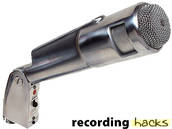 Electro-Voice 664
Electro-Voice 664
Cardioid Dynamic Microphone
The Electro-Voice 664 was designed as a public-address microphone in the 1950s. The mic is commonly used today in both amateur radio and studio applications; the mics can be purchased readily on Ebay for under $100.
The mic was a cardioid dynamic, designed to maintain a consistent cardioid pickup pattern over a wide frequency range, regardless of proximity. This feat was achieved through an innovation that E-V named “Variable-D™.”
US Patent 3115207, filed in January 1954 and granted in December 1963, is for “a unidirectional microphone having a substantially constant response for all frequencies within a predetermined range.” A second goal and benefit of the design covered by this patent is to reduce the proximity effect that is common to pressure-gradient transducers.
These goals were met by introducing a sort of acoustic baffle in a tube mounted parallel to the body of the microphone. This tube has multiple openings at variable distances (thus, “Variable-D”) from the diaphragm to allow sound pressure at different frequencies to act upon the back of the diaphragm. The vents furthest from the diaphragm were coupled to low-pass filters (interconnected acoustic chambers, some of which were covered in felt or some equivalent damping material), allowing the microphone to retain its directivity even for low-frequency sounds. As the Engineering spec puts it, “these three sound entrances, each utilizing the proper acoustical impedance, combine to form one effective back entrance which varies in distance from the diaphragm inversely with frequency.”
The mic’s “Acoustalloy” diaphragm was said to withstand high humidity, temperature extremes, mechanical shocks, and salt air. The Engineering datasheet claims “it is practically indestructible with normal use.” (This also helps explains why there is a steady supply of these mics on Ebay.)
The mic’s frequency response plot is not calibrated to 0dB, but it’s worth noting that this is not a flat-response mic. The graph shows a 7dB gain from 40Hz to 100Hz, another 5dB gain from 100Hz to 1kHz, and over 3dB of gain from 2kHz to 6kHz. There is a definite and distinct presence peak from 3–7kHz, and a large dropoff below 100Hz and above 11kHz.
The mic was available in two finishes:
- Satin Chrome, model 664A
- “Decorative” gold, model 664G
It was known for its durability as well as its sound characteristics. According to the AES obituary of Electro-Voice founder Lou Burroughs, the mic earned the nickname “Buchanan Hammer” honestly.
John Woram, 1986
Lou’s lectures were often hard to forget, as anyone who attended a demonstration of the E-V 664, the Buchanan Hammer, can testify. Lou would show up with a few mics, a piece of wood, and a nail. When the talk got around to the matter of durability, he’d unplug the 664, use it to pound the nail home, and then get on with the talk, having more than made his point.
Note: photo courtesy coutant.org.
The Electro-Voice 664 is also known as: 664A, 664G.
Specifications
| Pickup Patterns | Pads & Filters |
|---|---|
|
Cardioid
(60 - 15,000 Hz) |
|
| Coil Diameter | Impedance | SPL/Noise |
|---|---|---|
| n/a | 150 Ohms (Low) | SPL n/a |
| Weight | Length | Max Diameter | Interface(s) |
|---|---|---|---|
| 794g (28.01oz) | 183mm (7.20'') | 48mm (1.89'') |
| Power Specifications |
|---|
Did we get anything wrong on this page? Please let us know!
